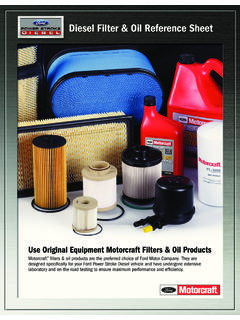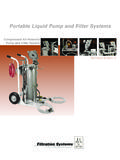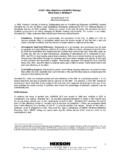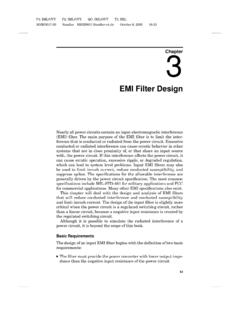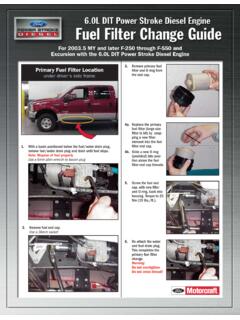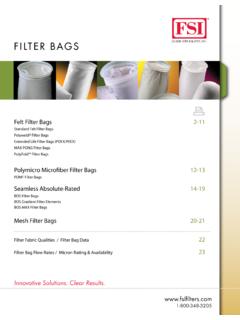Transcription of Nonwoven Filter Media - A Look Back, Trends and …
1 1 Nonwoven Filter Media A look Back, Trends and future market needs Clint Scoble Principal Filtration Consultant Filter Media Services, LLC, Cincinnati, OH Nonwovens in filtration probably sounds to the layman like an obscure, niche, boring topic. To those of us in the inside, either in the Filter Media area or in applying Filter Media to processes, products and filtration equipment, it is a complex, highly diversified and highly fragmented industry, both the Media side and the filtration arena. The two parts of the Nonwovens in Filtration subject require that we address each side independently and then bring them together at the end.
2 One analogy used to describe filtration is that it is a very large church with an equally large number of pews, many of which do not communicate or resemble each other. A list of the major filtration segments would include the following pews: Automotive (engine air, fuel, oil, cabin air) Clean Room Coolant and Lubricant Dust Collection ( Filter Bags, Pleated Cartridges, Pleated Bags, Cleanable) HVAC, Paint Spray Booth, Buss Duct, Make Up Air, Gas Turbine, Oil Mist, Coalescers Hydraulic and Line Liquid Process Filters (All Types, Cleanable) Medical, Pharmaceutical, Ultra Pure Potable Water Respirator, PPE Reverse Osmosis Swimming Pool and Spa The first major distinction between the items listed above is whether the Filter Media or manufactured filters are single use, essentially storage filters, or whether they are cleanable and capable of regeneration by a backwash, shake or mechanical Filter cake removal process.
3 Most of the pews are either 100% single use or 100% cleanable. Because cleanable Filter Media or manufactured filters require a wider range of performance characteristics, this presentation will focus on those products. 2 Single use filters may be characterized by an orientation toward low cost using less expensive Filter Media , often multiple layer, depth or storage design, held, fixed or supported in place with minimal Media movement. When the Media or manufactured Filter is filled with solids, blinded or will not effectively allow liquid or air flow, the Media or manufactured Filter must be replaced with a new Filter .
4 The most basic example of this is the common home furnace Filter . However, much more complicated, technically engineered single use filters are used in HEPA, clean room and medical filters. Many single use pews also have their own Media measuring systems where particle sizes, loadings and flow rates are used to challenge the Media to provide efficiency, flow and pressure drop ratings or categorizations (ASHRAE and MERV for example). In addition, there are industry specific test procedures. Lastly, a tremendous range of fibers, fabric designs and Filter configurations are used in the single use Filter area.
5 In cleanable Filter Media , there is a similar emphasis on cost. However, there are additional requirements of Filter cake release, durability, flexibility and resistance to mechanical wear adding to efficiency, flow and pressure drop. Because a cleanable Filter requires these additional features, cleanable Filter Media tends to be heavier, may focus more on surface cake buildup than depth filtration, will have special surface characteristics and may use chemical treatments to achieve certain performance levels. Rating systems are used to some degree but, because the potential end use applications are almost infinite, using a standard Arizona Road Dust to evaluate a Filter Media which might be used in flour milling for example, is relatively meaningless.
6 Although there are exceptions to every rule in filtration, the primary cleanable Filter areas are reverse osmosis, industrial dust collections and large industrial liquid process filters. Also, some swimming pool and spa filters are sold and designed as being cleanable by either backwash or manual means. Every industry has its Holy Grails, those product capabilities which make the best performing, longest lasting, highest capacity item, in turn making the end product more saleable and more valuable to the end user. Filtration is no different and the biggest Holy Grails, and some secondaries, are: I.
7 Holy Grails of Filtration 1. Higher Efficiency 2. Lower Pressure Drop 3. Higher Airflow 4. Longer Life 5. Lowest Cost vs Performance/Benefit 3 II. Secondary Grails 1. Greater Storage/Dirt Holding Capacity 2. Resistance to Blinding/Plugging 3. Optimum Cleanability 4. Improved Resistance to thermal, chemical, hydrolytic and oxidative degradation 5. Specific Performance Characteristics A. Static Dissipating B. Anti-bacterial, Anti-microbial C. Oil/Water Repellant D. Abrasion Resistant E. Spark Resistant In addition, current world, social, economic and environmental conditions have created a new set of Grails to add to the above: III.
8 New Grails 1. Disposibility/Recyclability 2. Sustainability 3. Green Impact in Production (minimal environmental impact) 4. Energy Savings How these new Grails will impact our industry, its producers and their products is still, to a degree, an unknown but major Media manufacturers are already moving to meet these objectives and to capitalize on them as well. The other half of the Nonwovens in Filtration equation is the Nonwoven Media , how it has evolved, what is available today and where it used to be. A brief history of Filter Media starts with ancient civilizations filtering water, wine and beer with woven fabrics made from natural fibers such as flax, cotton, wool or silk.
9 Pressed wool felts evolved according to legend when travelers strapped bunches of wool fibers to their feet. Woven 4 and pressed felt fabrics predominated in the filtration industry until the mid-20th century when needled felts became an integral part of industrial dust collection. Wet strength paper and cellulose/paper blends found their way into liquid filtration along with unidirectional rayon. The growth of synthetic fibers, starting with nylon in 1938, added significant opportunity for Filter manufacturers to broaden their products. New textile processes were developed using these new synthetic resins and fibers.
10 Adding to weaving and needling are today s better known, high volume, Nonwoven fabric manufacturing processes, including: Spunbonds Meltblowns Point/Ultrasonic Bonds Hydroentangled (spun laced) Airlaids Wetlaids Stitchbonds Chemical (other others) bonds Thermal Bonds Synthetic fiber non-wovens have dominated the filtration industry since the 1970 s because of (5) basic advantages: 1. High volume, low cost production processes producing lower cost Media (compared to wovens) 2. Variability of weights, permeabilities, surfaces, widths, and other basic characteristics 3.
